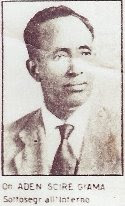 WASHINGTON — American officials say they are seeing the first evidence that dozens of fighters with Al Qaeda, and a small handful of the terrorist group’s leaders, are moving to Somalia and Yemen from their principal haven in Pakistan’s tribal areas. In communications that are being watched carefully at the Pentagon, White House and Central Intelligence Agency, the terror groups in all three locations are now communicating more frequently, and apparently trying to coordinate their actions, the officials said. Some aides to President Obama attribute the moves to pressure from intensified drone attacks against Qaeda operatives in Pakistan, after years of unsuccessful American efforts to dislodge the terror group from their haven there. But there are other possible explanations. Chief among them is the growth of the jihadist campaigns in both Somalia and Yemen, which may now have some of the same appeal for militants that Iraq did after the American military invasion there in 2003. Somalia is now a failed state that bears some resemblance to Afghanistan before the Sept. 11, 2001, attacks, while Yemen’s weak government is ineffectually attempting to combat the militants, American officials say. The shift of fighters is still small, perhaps a few dozen, and there is no evidence that the top leaders — Osama bin Laden and Ayman al-Zawahri — are considering a move from their refuge in the Pakistani tribal areas, according to more than half a dozen senior administration, military and counterterrorism officials interviewed in recent days. Most officials would not comment on the record about the details of what they are seeing, because of the sensitivity of the intelligence information they are gathering.Leon E. Panetta, the C.I.A. director, said in remarks here on Thursday that as Al Qaeda came under increasing pressure in Pakistan, the United States must prevent the terrorist group from creating a new sanctuary in Yemen or Somalia.The steady trickle of fighters from Pakistan could worsen the chaos in Somalia, where the Islamic militant group, the Shabab, has attracted hundreds of foreign jihadists in its quest to topple the weak moderate Islamist government in Mogadishu. It could also swell the ranks of a growing menace in Yemen, where militants now control large swaths of the country outside the capital.
WASHINGTON — American officials say they are seeing the first evidence that dozens of fighters with Al Qaeda, and a small handful of the terrorist group’s leaders, are moving to Somalia and Yemen from their principal haven in Pakistan’s tribal areas. In communications that are being watched carefully at the Pentagon, White House and Central Intelligence Agency, the terror groups in all three locations are now communicating more frequently, and apparently trying to coordinate their actions, the officials said. Some aides to President Obama attribute the moves to pressure from intensified drone attacks against Qaeda operatives in Pakistan, after years of unsuccessful American efforts to dislodge the terror group from their haven there. But there are other possible explanations. Chief among them is the growth of the jihadist campaigns in both Somalia and Yemen, which may now have some of the same appeal for militants that Iraq did after the American military invasion there in 2003. Somalia is now a failed state that bears some resemblance to Afghanistan before the Sept. 11, 2001, attacks, while Yemen’s weak government is ineffectually attempting to combat the militants, American officials say. The shift of fighters is still small, perhaps a few dozen, and there is no evidence that the top leaders — Osama bin Laden and Ayman al-Zawahri — are considering a move from their refuge in the Pakistani tribal areas, according to more than half a dozen senior administration, military and counterterrorism officials interviewed in recent days. Most officials would not comment on the record about the details of what they are seeing, because of the sensitivity of the intelligence information they are gathering.Leon E. Panetta, the C.I.A. director, said in remarks here on Thursday that as Al Qaeda came under increasing pressure in Pakistan, the United States must prevent the terrorist group from creating a new sanctuary in Yemen or Somalia.The steady trickle of fighters from Pakistan could worsen the chaos in Somalia, where the Islamic militant group, the Shabab, has attracted hundreds of foreign jihadists in its quest to topple the weak moderate Islamist government in Mogadishu. It could also swell the ranks of a growing menace in Yemen, where militants now control large swaths of the country outside the capital.“I am very worried about growing safe havens in both Somalia and Yemen, specifically because we have seen Al Qaeda leadership, some leaders, start to flow to Yemen,” Adm. Mike Mullen, the chairman of the Joint Chiefs of Staff, said in remarks at the Brookings Institution here on May 18. For the United States, the movement creates opportunities as well as risks. With the Obama administration focusing its fight against the Taliban and Al Qaeda on the havens in Afghanistan and Pakistan, a shift of fighters and some leaders to new locations could complicate American efforts to strike a lasting blow. But in the tribal areas of Pakistan, Qaeda and Taliban forces have drawn for protection on Pashtun tribes with whom they have deep familial and tribal ties. A move away from those areas could expose Qaeda leaders to betrayal, while communications among militants in Pakistan, Somalia and Yemen have created a new opportunity for American intelligence to zero in on insurgents who gave up many electronic communication devices shortly after the Sept. 11 attacks to avoid detection. A senior Obama administration official attributed some of the movement to “the enormous heat we’ve been putting on the leadership and the mid-ranks” with Predator strikes, launched from both Pakistan and Afghanistan. Mr. Obama’s strategy so far has been to intensify many of the strikes begun under the Bush administration, though they have been a source of continuing tension with in Pakistan, largely because of civilian casualties.“There are indications that some Al Qaeda terrorists are starting to see the tribal areas of Pakistan as a tough place to be,” said an American counterterrorism official. “It is likely that a small number have left the region as a result. Among these individuals, some have probably ended up in Somalia and Yemen, among other places. The Al Qaeda terrorists who are leaving the tribal areas of Pakistan are predominantly foot soldiers.”
Measuring the numbers of these movements is almost as difficult as assessing the motivations of those who are on their way out of the tribal areas. American intelligence assets are weak in Pakistan’s tribal areas, and they are little better in Somalia and Yemen. But American officials say there is evidence of a shift. One senior American military official who follows Africa closely said that more than 100 foreign fighters had trained in terrorism camps in Somalia alone in the past few years. Another senior military officer said that Qaeda operatives and confederates in Pakistan, Yemen and Somalia had stepped up communications with one another. “What really has us worried is that they’re communicating with each other much more — Al Qaeda in Pakistan, Somalia and Yemen,” the senior military officer said. “They’re asking, ‘What do you need? Financing? Fighters?’ ” Mr. Obama’s strategy for Afghanistan and Pakistan placed the defeat of Al Qaeda as the No.1 objective, largely to make sure that the group could not plot new attacks against the United States. Thus, the movement of the fighters, and the disruption that causes, has been interpreted by some of the president’s top advisers as a sign of success.
But the emergence of new havens, from which Al Qaeda and its affiliates could plot new attacks, raises difficult questions for the United States on how to combat the growing threat, and creates the possibility that increased missile strikes are in the offing in Yemen and Somalia. “Those are issues that I think the international community is going to have to address becauseAl Qaeda is not going away,” Admiral Mullen told a Senate committee on May 21. The C.I.A. says its drone attacks in Pakistan have disrupted Al Qaeda’s operations and damaged the group’s senior ranks. American officials say that strikes have killed 11 of top 20 Qaeda leaders in the past year. “Al Qaeda has been hit by drones and it has generated a lot of insecurity among them,” said Talat Masood, a retired Pakistani general and military analyst in Islamabad.“Many among them are uneasy and it is possible that they are leaving for Somalia and other jihadi battle fronts. The hard core, however, will like stay on.” Without singling out any countries, Adm. Eric T. Olson, the head of the Special Operations Command, spoke in general terms last week about how the increased Pakistani military operations in Swat Valley and early indications of a new Pakistani offensive in South Waziristan had put militants on the run. “As the Pakistanis are applying pressure,” Admiral Olson told a House panel, “it will shift some of the sanctuaries to other places.” ...Jack Styczynski contributed reporting from New York.
AL-QAIDA'S MONEY TROUBLE
http://www.canada.com/news/QAIDA+MONEY+TROUBLE/1698175/story.html



.jpg)











No comments:
Post a Comment